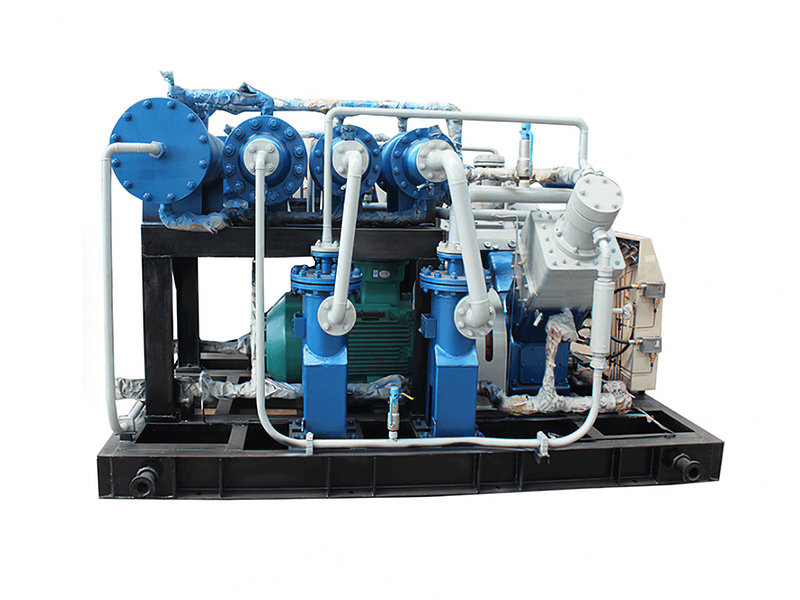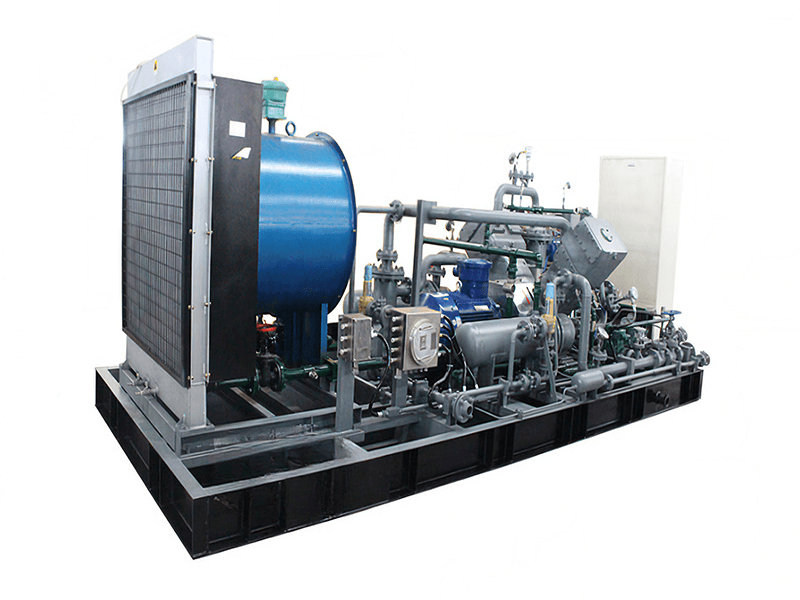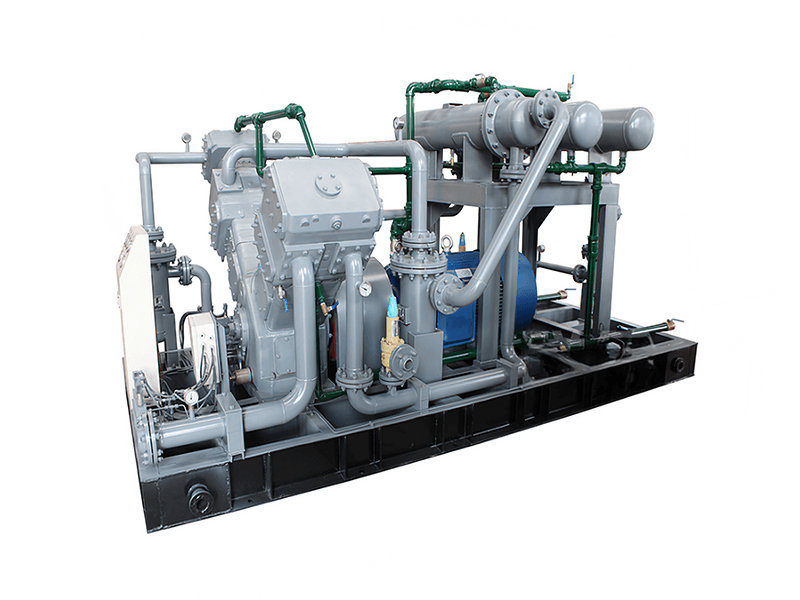A hydrogen compressor is a mechanical device used to increase the pressure of hydrogen gas. It takes in hydrogen at a lower pressure and delivers it at a higher pressure, enabling the gas to be stored, transported, or used in various industrial processes. Hydrogen compressors are essential for applications that require pressurized hydrogen, such as hydrogen fueling stations, hydrogen storage facilities, chemical processes, and power generation.
Hydrogen compressors often include features such as inlet filters, discharge valves, pressure gauges, cooling systems, and safety mechanisms to ensure efficient and reliable operation. It is crucial to select a hydrogen compressor that meets the specific requirements of the application, considering factors such as pressure range, flow capacity, gas purity, energy efficiency, and maintenance needs.
Hydrogen compression is an important step in the hydrogen supply chain, enabling the utilization of hydrogen as a clean and versatile energy carrier. Proper design, operation, and maintenance of hydrogen compressors are essential for ensuring safe and efficient hydrogen handling and utilization.

Working principle of a hydrogen compressor
The working principle of a hydrogen compressor involves the compression of hydrogen gas to increase its pressure. Hydrogen compressors are typically positive displacement machines that use various mechanisms to achieve compression.
There are several types of hydrogen compressors, each with its own working principle. Here are the commonly used types and their working principles:
Reciprocating (Piston) Compressor:
Working Principle: Reciprocating compressors use one or more pistons that move back and forth inside cylinders. The piston's motion creates compression by reducing the volume of the cylinder, thereby increasing the pressure of the hydrogen gas. The intake and discharge valves control the flow of gas into and out of the cylinder.
Application: Reciprocating compressors are suitable for small to medium-scale hydrogen compression applications.
Rotary Screw Compressor:
Working Principle: Rotary screw compressors employ two intermeshing screws (rotors) that rotate in opposite directions. As the rotors turn, the hydrogen gas is trapped in the space between the rotors and the compressor casing. The gas is compressed as it moves along the screw grooves, resulting in an increase in pressure.
Application: Rotary screw compressors are known for their continuous operation and are used in various industrial applications, including hydrogen compression.
Centrifugal Compressor:
Working Principle: Centrifugal compressors use an impeller that rotates at high speeds to accelerate the hydrogen gas. The impeller draws in the gas axially and imparts kinetic energy to it. The high-velocity gas is then directed to a diffuser, which converts the kinetic energy into pressure energy, resulting in compressed hydrogen.
Application: Centrifugal compressors are commonly used for large-scale hydrogen compression, such as in hydrogen production plants and industrial gas supply systems.
Diaphragm Compressor:
Working Principle: Diaphragm compressors utilize a flexible diaphragm that moves back and forth to compress the hydrogen gas. As the diaphragm moves outward, it creates a vacuum, drawing in the gas. When the diaphragm moves inward, it compresses the gas, increasing its pressure.
Application: Diaphragm compressors are suitable for applications that require high gas purity and oil-free compression, such as in hydrogen fueling stations and industries where contamination must be minimized.
These are the main types of hydrogen compressors and their working principles. The selection of a compressor type depends on factors such as the required pressure range, flow rate, gas purity, energy efficiency, and specific application requirements.
Hydrogen compressor types
Hydrogen compressors come in different types and configurations, including reciprocating (piston) compressors, rotary screw compressors, centrifugal compressors, and diaphragm compressors. The specific type of compressor used depends on factors such as the required pressure ratio, flow rate, gas purity, and application requirements. Reciprocating compressors are commonly used for small to medium-scale hydrogen compression. They utilize pistons and cylinders to compress the gas through a reciprocating motion. Rotary screw compressors use intermeshing rotors to compress the gas, providing continuous operation and higher capacity. Centrifugal compressors use an impeller and diffuser to accelerate and compress the gas through centrifugal force. Diaphragm compressors incorporate flexible diaphragms that move back and forth to compress the gas, making them suitable for applications that require high purity and oil-free compression.
Here are some additional details about the working principles of hydrogen compressors:
Rotary Screw Hydrogen Compressor: In a rotary screw compressor, two helical rotors are used to compress the hydrogen gas. As the rotors rotate, the gas is trapped in the spaces between the rotors and the compressor casing. As the rotors mesh together, the gas is compressed and discharged through the outlet. Rotary screw compressors are known for their continuous operation and high efficiency.
Centrifugal Hydrogen Compressor: Centrifugal compressors use an impeller and a diffuser to compress the hydrogen gas. The impeller, driven by a motor, rotates at high speeds, creating centrifugal force that accelerates the gas. The diffuser then converts the high-velocity gas into high-pressure gas by slowing it down and converting kinetic energy into pressure. Centrifugal compressors are commonly used for large-scale hydrogen compression applications.
Diaphragm Hydrogen Compressor: Diaphragm compressors use a flexible diaphragm that moves back and forth to compress the hydrogen gas. When the diaphragm moves outward, the gas is drawn into the compression chamber. As the diaphragm moves inward, the gas is compressed, and the pressure increases. Diaphragm compressors are often used for applications requiring high purity and oil-free compression.
Piston-Type Hydrogen Compressor: Piston compressors, including reciprocating compressors, use a piston and cylinder arrangement to compress the hydrogen gas. The piston moves back and forth inside the cylinder, creating compression during the upward stroke. The gas is drawn into the cylinder during the downward stroke, and the process repeats. Piston compressors are versatile and widely used in various hydrogen compression applications.
These are just a few examples of different types of hydrogen compressors and their working principles. Each type has its advantages and is suitable for specific applications based on factors such as capacity, pressure requirements, efficiency, and gas purity considerations. The selection of a hydrogen compressor depends on the specific needs and constraints of the application at hand.


























